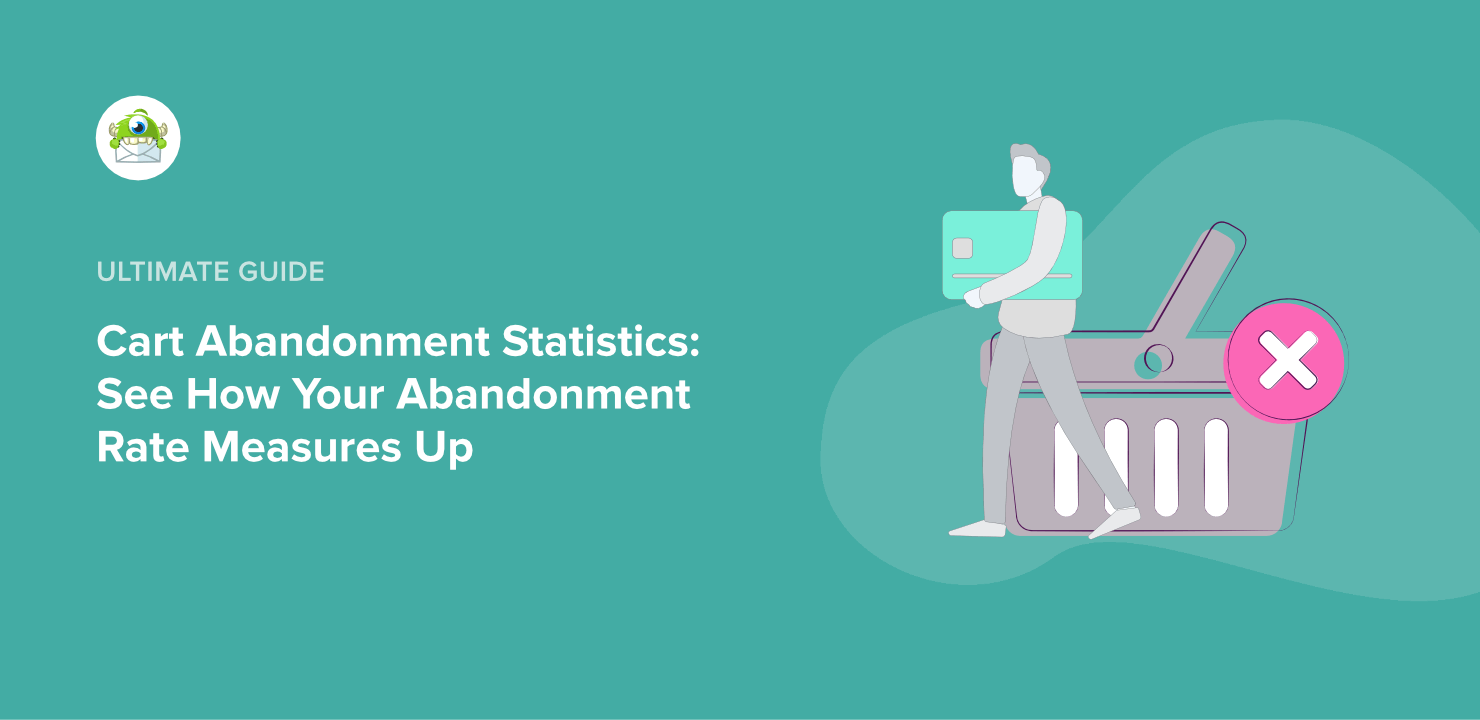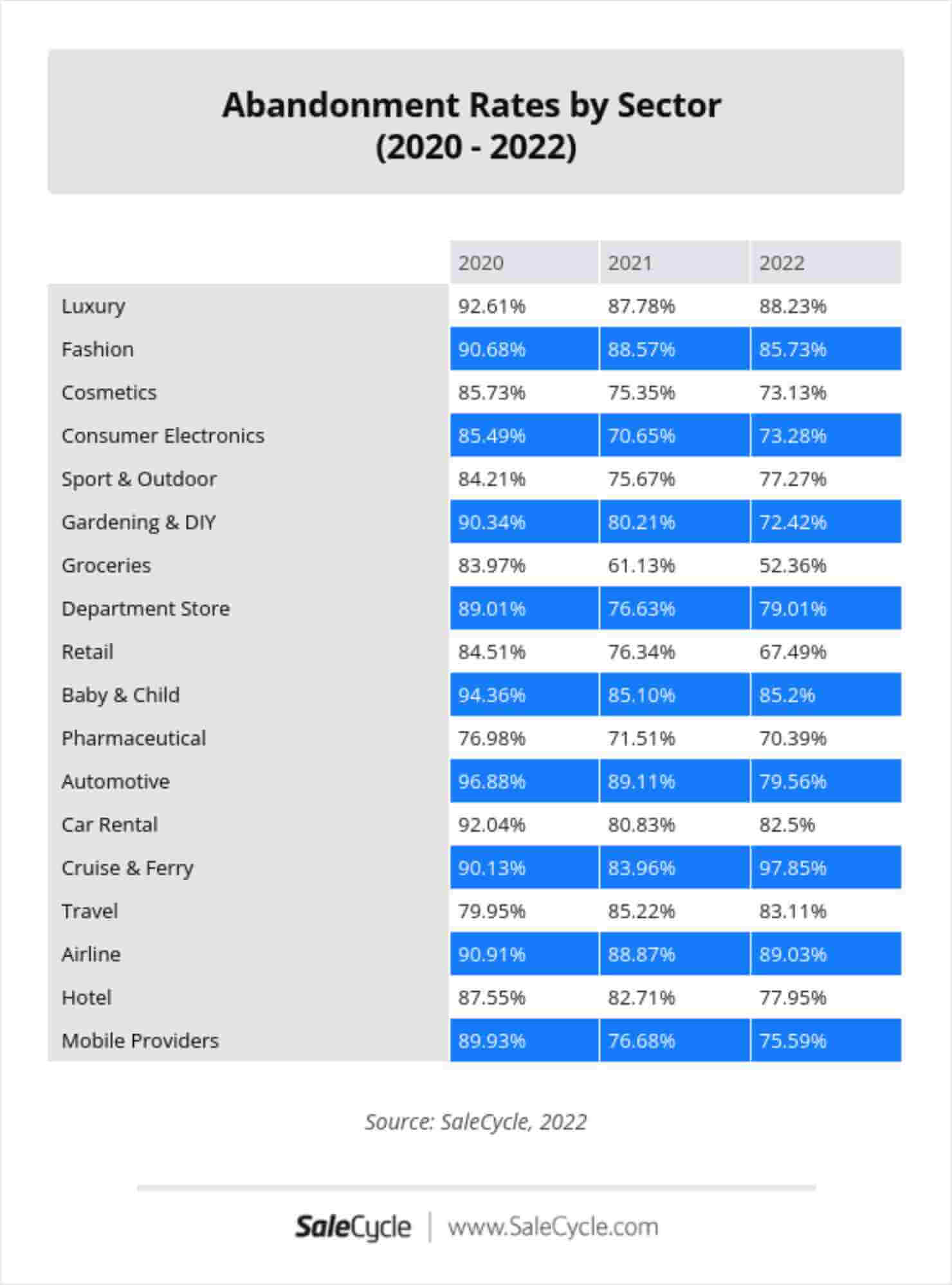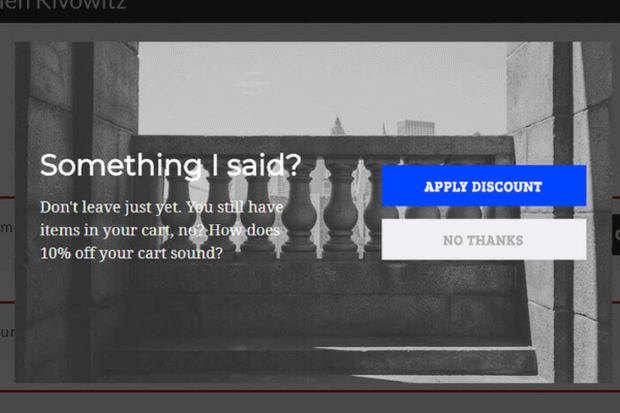Are you uncertain about your eCommerce business’s cart abandonment rate? If you want to fully understand how your online store measures up, you need to review reliable cart abandonment statistics to see how your metrics compare.
In this article, I’ll share 9 important cart abandonment stats gathered from trusted sources. For each statistic, I’ll also explain why that data matters to your own cart abandonment strategy.
- What Is Cart Abandonment Rate?
- 9+ Cart Abandonment Stats (& Why They Matter)
- 1. Average Cart Abandonment Rate
- 2. Mobile Cart Abandonment Rate
- 3. Cart Abandonment Rates by Industry
- 4. Amount of Lost Revenue
- 5. Potential Lost Revenue Recovery
- 6. Top Reasons for Cart Abandonment
- 7. Abandoned Cart Recovery With Exit Popups
- 8. Abandoned Cart Email Open Rate
- 9. Abandoned Cart Email Revenue Per Recipient (RPR)
What Is Cart Abandonment Rate?
A cart abandonment rate is the percentage of online shoppers who add products to their cart but leave the site before they actually purchase the items.
It’s the eCommerce equivalent of walking away from your grocery store cart while you’re deciding between Fruity Pebbles and Cinnamon Toast Crunch.
Reducing cart abandonment is a big part of our business here at OptinMonster. Our popups, floating bars, and other onsite marketing campaigns help you encourage shoppers to complete their purchases.
If you want to dig deeper into the topic of shopping cart abandonment, check out this article, which shows you how to calculate your cart abandonment rate and discusses the top reasons for abandonment.
See Our Complete GuideShopping Cart Abandonment: Definition, Data, & How to Regain Lost Revenue
9+ Cart Abandonment Stats (& Why They Matter)
1. The Average Shopping Cart Abandonment Rate Is 70.19%
The Baymard Institute has compiled 49 cart abandonment studies from the past 18 years. They’ve found that the average cart abandonment rate during that time period is just over 70%.
Among the studies conducted since 2020, the highest rate cited was 84.27% and the lowest was 57.6%
Why This Statistic Matters: In order to reduce cart abandonment, you need to understand that most shoppers will abandon their carts, at least on their initial visit.
However, you can use Exit-Intent® popups, email marketing, and OnSite Retargeting® campaigns to encourage those shoppers to eventually buy.
Here’s an example of an Exit-Intent® popup that one of our OptinMonster customers has used. It offers a discount code as a lead magnet in exchange for the visitor’s email address.
A coupon code is a great incentive to convince abandoning shoppers to make a purchase soon. Plus, now they’re on your email list, so you can continue marketing to them through promotional emails.
2. The Mobile Cart Abandonment Rate Is at Least 12 Percentage Points Higher Than Desktop
According to device-specific data from Barilliance, mobile users are more likely to abandon their carts than people shopping on their laptop or desktop device. They’re also more likely to abandon than tablet users. Here are the exact numbers:
- Mobile Cart Abandonment Rate: 85.65%
- Tablet Cart Abandonment Rate: 80.74%
- Desktop Cart Abandonment Rate: 73.07%
Other studies show an even sharper contrast. SaleCycle provides cart abandonment data from their client base, and here were their numbers for 2021:
- Mobile Cart Abandonment Rate: 71.72%
- Desktop Cart Abandonment Rate: 28.28%
These cart abandonment statistics make a lot of sense. After all, people shopping on their mobile devices are often browsing casually. They may even be shopping while doing another activity, such as watching TV.
Why This Statistic Matters: Since mobile shoppers are more likely to abandon their carts, you need to use mobile-specific strategies to win them back:
- Make sure your website is optimized for mobile, so users don’t leave out of frustration.
- OptinMonster lets you create mobile-optimized popups and floating bars and target them specifically to mobile users.
All of OptinMonster’s 700+ pre-made templates are responsive on all devices. However, if you select Mobile Optimized during your template search, you’ll see that we offer dozens of templates designed specifically for mobile screens:
Taking a mobile-first approach can help you recover more of those lost mobile sales.
3. Cart Abandonment Rates Vary Widely (52.36% – 97.85%) by Industry
SaleCycle also breaks down their clients’ cart abandonment rates by sector:
As of 2022, the sectors with the highest cart abandonment were:
- Cruise & Ferry: 97.85%
- Airline: 89.03%
- Luxury: 88.23%
- Fashion: 85.73%
The sectors with the lowest rates were:
- Groceries: 52.36%
- Retail: 67.49%
- Pharmaceutical: 70.39%
- Gardening & DIY: 72.42%
As you can see, high-price products have higher cart abandonment, while customers are more likely to complete purchases of more day-to-day items.
Why This Statistic Matters: If you want to benchmark your company’s abandonment rate, don’t simply compare yourself to the overall average. Pay attention to your industry and the types of products and price points you offer.
4. Abandoned Carts Cost Businesses $4.6 trillion in Revenue
Business Insider estimates that $4.6 trillion worth of merchandise is left in abandoned carts every year. That’s not a huge surprise, given that the overall cart abandonment rate is so high.
Why This Statistic Matters: When it comes to abandoned cart recovery, there’s a lot of money on the table. If you can reduce your abandonment rate by even just a few percentage points, you can make a big difference to your bottom line.
5. Improved Checkout Could Recover $260 Billion in Lost Sales
As part of Baymard Institute’s in-depth cart abandonment research, they ask an important question: How much of the revenue from abandoned carts is recoverable?
They estimate that, in the US and EU alone, $260 million in revenue could be recovered through better checkout flow and design.
Why This Statistic Matters: User experience is integral to checkout page optimization. When your checkout process is simple and easy to use, more shoppers will complete their purchases.
And remember this: that $260 million figure is just the amount that could be recovered from improving checkout processes. Other strategies, such as exit popups and abandoned cart emails, can recover even more.
6. 47% of Shoppers Have Abandoned a Cart Because of Extra Costs
In 2023, the Baymard Institute surveyed over 2,219 US adults and asked them what their reasons were for abandoning a checkout process during the previous 3 months.
A whopping 47% said they had abandoned a cart due to extra costs, such as shipping, taxes, and fees.
Note: Baymard Institute’s data excludes “I was just browsing” as a reason for abandonment. Many visitors add items to their carts as they window shop online. These shoppers have no intention of making a purchase right away, but they may at a later time.
Why This Statistic Matters: Shoppers don’t like surprises during their checkout experience. For instance, a visitor might add a $100 item to their cart and start completing their purchase. They reach the final page of checkout and see the total is actually $147 after shipping costs and fees are added.
If they’re not prepared to pay that amount, they’re likely to abandon that cart, and you’ll lose a sale.
Your marketing team spent time, money, and effort in attracting that lead. And now your potential customer is gone in an instant.
To avoid thee losses, be as up-front as possible with all extra costs. If you can, offer free shipping to customers who spend a certain amount. In addition to avoiding abandonment, free shipping is also a powerful upselling technique.
Related GuideHow to Add a Free Shipping Floating Bar to ‘Your Online Store
As you can see in the chart above, unexpected cost is just one reason for abandonment. Here are a few tips to combat other reasons:
- Enable guest checkout
- Create a single-page checkout and make it ridiculously simple
- Allow multiple payment methods (for instance, including PayPal and Apple Pay as payment options in addition to credit cards)
- Show site security seals and trust badges
- Clearly state your return policy
7. Exit-Intent® Popups Can Recover 21% of Abandoned Carts
OptinMonster’s Exit-Intent® popups let you catch the attention of abandoning visitors with an enticing offer. Plus, you can collect their email address so you build a relationship through your email newsletter.
OptinMonster customer Scott Wyden Imagery created a cart abandonment popup for his WooCommerce store, which he integrated with OptinMonster.
This popup appeared when a visitor with items in their cart tried to exit the site or was inactive for at least 60 seconds.
The result: Scott Wyden Imagery recovered 21% of those carts. He also used other OptinMonster popups to grow his email list by 328%!
Read the full case studyHow Scott Wyden Imagery Recovered 21% of Abandoned Carts & Grew His List 3x
Why This Statistic Matters: If your cart abandonment rate is 70%, that means only 30% of people who add items to their cart complete their purchase. If you recover 21% of those abandoned carts, that would equal a 50% increase in completed purchases.
Think of how transformative those sales could be for your business.
8. Abandoned Cart Emails Have a 50.5% Open Rate
I’m going to close our list of cart abandonment stats with 2 statistics about abandoned cart emails.
According to Klaviyo’s 2024 email marketing data, abandoned cart emails have an open rate of 50.5%. The same study shows that the average open rate for all eCommerce emails is 39.74%.
That means abandoned cart emails are opened 27% more often than other email campaigns.
Why This Statistic Matters: Shoppers want to be reminded of items they’ve left in their online shopping carts. If they didn’t, then they wouldn’t be opening those cart abandonment emails. Not only do these emails help you win more sales, but you’re also providing communication that customers expect.
9. Abandoned Cart Email Flows Earn an Average of $3.65 Per Recipient
Klaviyo’s 2024 Benchmark Report also tracks the average revenue per recipient (RPR) for various types of automated email flows. Abandoned cart emails are by far the most profitable with an average $3.65 RPR.
Compare that number to the next highest types of automated flows:
- Welcome flow: $2.65 RPR
- Abandoned browsing flow: $1.07 RPR
- Post-purchase flow: $0.41 RPR
Klaviyo also notes that for the top 10% of performers, the average RPR for abandoned cart emails is a phenomenal $28.89. If you fully optimize your email strategy, you can see your revenue soar.
Why This Statistic Matters: You already know that reducing cart abandonment rate will increase your revenue. But this data gives you a dollar amount tied to a specific action: sending abandoned cart emails.
In short, every eCommerce store needs to send abandoned cart emails. Here are a few resources to help:
- How to Create an Abandoned Cart Email Strategy That Skyrockets Sales
- 14 Abandoned Cart Email Examples Proven to Boost Revenue
- 27 Abandoned Cart Email Subject Lines That Convert
Lower Cart Abandonment Rate = More Sales
With these cart abandonment statistics, you can see how your cart abandonment rate measures up and develop a strategy to improve it.
If you want to stop abandoning visitors in their tracks, OptinMonster should be the #1 tool in your cart recovery efforts. With our onsite marketing campaigns, easy-to-use templates, and robust targeting and triggering rules, you can start winning more sales, fast.
















Add a Comment